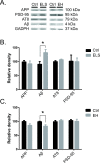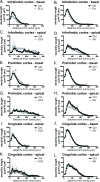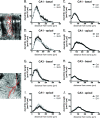Positive and negative early life experiences differentially modulate long term survival and amyloid protein levels in a mouse model of Alzheimer's disease
- PMID: 27259247
- PMCID: PMC5129918
- DOI: 10.18632/oncotarget.9776
Positive and negative early life experiences differentially modulate long term survival and amyloid protein levels in a mouse model of Alzheimer's disease
Abstract
Stress has been implicated as a risk factor for the severity and progression of sporadic Alzheimer's disease (AD). Early life experiences determine stress responsivity in later life, and modulate age-dependent cognitive decline. Therefore, we examined whether early life experiences influence AD outcome in a bigenic mouse model which progressively develops combined tau and amyloid pathology (biAT mice).Mice were subjected to either early life stress (ELS) or to 'positive' early handling (EH) postnatally (from day 2 to 9). In biAT mice, ELS significantly compromised long term survival, in contrast to EH which increased life expectancy. In 4 month old mice, ELS-reared biAT mice displayed increased hippocampal Aβ levels, while these levels were reduced in EH-reared biAT mice. No effects of ELS or EH were observed on the brain levels of APP, protein tau, or PSD-95. Dendritic morphology was moderately affected after ELS and EH in the amygdala and medial prefrontal cortex, while object recognition memory and open field performance were not affected. We conclude that despite the strong transgenic background, early life experiences significantly modulate the life expectancy of biAT mice. Parallel changes in hippocampal Aβ levels were evident, without affecting cognition of young adult biAT mice.
Keywords: Alzheimer; Gerotarget; biAT; early handling; early life stress; glucocorticoids.
Conflict of interest statement
CONFLICTS OF INTERESTS The authors declare no actual or potential conflicts of interests.
Figures







Similar articles
-
Vulnerability and resilience to Alzheimer's disease: early life conditions modulate neuropathology and determine cognitive reserve.Alzheimers Res Ther. 2018 Sep 19;10(1):95. doi: 10.1186/s13195-018-0422-7. Alzheimers Res Ther. 2018. PMID: 30227888 Free PMC article. Review.
-
Early-life stress lastingly alters the neuroinflammatory response to amyloid pathology in an Alzheimer's disease mouse model.Brain Behav Immun. 2017 Jul;63:160-175. doi: 10.1016/j.bbi.2016.12.023. Epub 2016 Dec 25. Brain Behav Immun. 2017. PMID: 28027926
-
Synaptic dysfunction in hippocampus of transgenic mouse models of Alzheimer's disease: a multi-electrode array study.Neurobiol Dis. 2011 Dec;44(3):284-91. doi: 10.1016/j.nbd.2011.07.006. Epub 2011 Jul 18. Neurobiol Dis. 2011. PMID: 21807097
-
Early postnatal handling reduces hippocampal amyloid plaque formation and enhances cognitive performance in APPswe/PS1dE9 mice at middle age.Neurobiol Learn Mem. 2017 Oct;144:27-35. doi: 10.1016/j.nlm.2017.05.016. Epub 2017 Jun 1. Neurobiol Learn Mem. 2017. PMID: 28579367
-
Early life stress and brain development: Neurobiological and behavioral effects of chronic stress.Prog Brain Res. 2025;291:49-79. doi: 10.1016/bs.pbr.2025.01.004. Epub 2025 Feb 6. Prog Brain Res. 2025. PMID: 40222792 Review.
Cited by
-
Chronic early life stress induced by limited bedding and nesting (LBN) material in rodents: critical considerations of methodology, outcomes and translational potential.Stress. 2017 Sep;20(5):421-448. doi: 10.1080/10253890.2017.1343296. Epub 2017 Jul 12. Stress. 2017. PMID: 28617197 Free PMC article.
-
Vulnerability and resilience to Alzheimer's disease: early life conditions modulate neuropathology and determine cognitive reserve.Alzheimers Res Ther. 2018 Sep 19;10(1):95. doi: 10.1186/s13195-018-0422-7. Alzheimers Res Ther. 2018. PMID: 30227888 Free PMC article. Review.
-
Neurostimulation Combined With Cognitive Intervention in Alzheimer's Disease (NeuroAD): Study Protocol of Double-Blind, Randomized, Factorial Clinical Trial.Front Aging Neurosci. 2018 Nov 2;10:334. doi: 10.3389/fnagi.2018.00334. eCollection 2018. Front Aging Neurosci. 2018. PMID: 30450044 Free PMC article.
-
Experiencing El Niño conditions during early life reduces recruiting probabilities but not adult survival.R Soc Open Sci. 2018 Jan 17;5(1):170076. doi: 10.1098/rsos.170076. eCollection 2018 Jan. R Soc Open Sci. 2018. PMID: 29410788 Free PMC article.
-
Cognitive Effects of Simulated Galactic Cosmic Radiation Are Mediated by ApoE Status, Sex, and Environment in APP Knock-In Mice.Int J Mol Sci. 2024 Aug 29;25(17):9379. doi: 10.3390/ijms25179379. Int J Mol Sci. 2024. PMID: 39273325 Free PMC article.
References
-
- Selkoe DJ, Schenk D. Alzheimer's disease: molecular understanding predicts Amyloid-based therapeutics. Annu Rev Pharmacol Toxicol. 2003;43:545–584. - PubMed
-
- Braak H, Braak E. Evolution of the neuropathology of Alzheimer's disease. Acta Neurol Scand Suppl. 1996;165:3–12. - PubMed
-
- Sydow A, Van der Jeugd A, Zheng F, Ahmed T, Balschun D, Petrova O, Drexler D, Zhou L, Rune G, Mandelkow E, D'Hooge R, Alzheimer C, Mandelkow EM. Tau-induced defects in synaptic plasticity, learning, and memory are reversible in transgenic mice after switching off the toxic tau mutant. J Neurosci. 2011;31:2511–2525. - PMC - PubMed
-
- Campion D, Dumanchin C, Hannequin D, Dubois B, Belliard S, Puel M, Thomas-Anterion C, Michon A, Martin C, Charbonnier F, Raux G, Camuzat A, Penet C, et al. Early-onset autosomal dominant Alzheimer disease: prevalence, genetic heterogeneity, and mutation spectrum. Am J Hum Genet. 1999;65:664–670. - PMC - PubMed
MeSH terms
Substances
LinkOut - more resources
Full Text Sources
Other Literature Sources
Medical
Molecular Biology Databases

